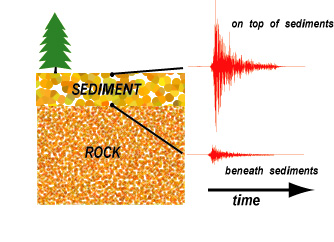|
Factors controlling ground shaking |
| In addition to earthquake recurrence, hazard also depends on how amplitudes of earthquake waves die out as they move away from the earthquake source to the affected site. It is well known that wave energy decreases much more slowly in the Central and Eastern United States than in the West. For the same size earthquake, this leads to greater shaking over larger areas, or higher hazard, in the Central and Eastern United States. Earthquake shaking also may be significantly amplified or damped by the soils immediately beneath a site. This is particularly true for thick sediments that underlie most of the New Madrid seismic zone. Recent research has highlighted the potential amplification of ground shaking by these thick sediments and has begun to shed light on the physical processes that cause this. Because characterization of this amplification |
|
requires detailed mapping of the soils and their properties, amplification characteristics are not included in the National Seismic Hazard Maps. Efforts are underway, however, to produce complementary maps that do show these amplification characteristics on scales appropriate for use in urban planning, earthquake hazard mitigation, and response planning efforts. |
|
When waves of a small earthquake impinge on the boundary between hard rock and overlying sediments from below (lower seismogram), they become amplified as they travel through the sediments to the surface (upper seismogram). A seismogram records the wave motion over time. The amplifying effects of thick sediments above the New Madrid seismic zone results in motions at the surface that are many times larger than below. (Courtesy of C. Langston, The University of Memphis.) |
| For more information contact: |
| Joan Gomberg Eugene Schweig U.S. Geological Survey 3876 Central Avenue Suite 2 Memphis, TN 38152-3050 901-678-4858 gomberg@usgs.gov |
| Web graphic design and layout by Pamela Svendsen Detra and Tracy Roudebush |
